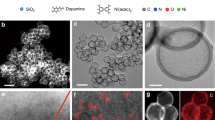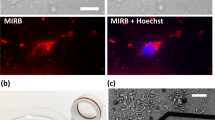Abstract
Understanding the function of nitric oxide, a lipophilic messenger in physiological processes across nervous, cardiovascular and immune systems, is currently impeded by the dearth of tools to deliver this gaseous molecule in situ to specific cells. To address this need, we have developed iron sulfide nanoclusters that catalyse nitric oxide generation from benign sodium nitrite in the presence of modest electric fields. Locally generated nitric oxide activates the nitric oxide-sensitive cation channel, transient receptor potential vanilloid family member 1 (TRPV1), and the latency of TRPV1-mediated Ca2+ responses can be controlled by varying the applied voltage. Integrating these electrocatalytic nanoclusters with multimaterial fibres allows nitric oxide-mediated neuronal interrogation in vivo. The in situ generation of nitric oxide in the ventral tegmental area with the electrocatalytic fibres evoked neuronal excitation in the targeted brain region and its excitatory projections. This nitric oxide generation platform may advance mechanistic studies of the role of nitric oxide in the nervous system and other organs.
This is a preview of subscription content, access via your institution
Access options
Access Nature and 54 other Nature Portfolio journals
Get Nature+, our best-value online-access subscription
$29.99 / 30 days
cancel any time
Subscribe to this journal
Receive 12 print issues and online access
$259.00 per year
only $21.58 per issue
Buy this article
- Purchase on Springer Link
- Instant access to full article PDF
Prices may be subject to local taxes which are calculated during checkout





Similar content being viewed by others
Data availability
The data that support the plots within this paper and other findings of this study are available from the corresponding authors upon reasonable request.
Code availability
All scripts are available from the corresponding author upon reasonable request.
References
Bredt, D. S. & Snyder, S. H. Nitric oxide: a physiologic messenger molecule. Annu. Rev. Biochem. 63, 175–195 (1994).
Mustafa, A. K., Gadalla, M. M. & Snyder, S. H.Signaling by gasotransmitters. Sci. Signal. 2, (2009).
Yoshida, T. et al. Nitric oxide activates TRP channels by cysteine S-nitrosylation. Nat. Chem. Biol. 2, 596 (2006).
Lundberg, J. O., Weitzberg, E. & Gladwin, M. T. The nitrate–nitrite–nitric oxide pathway in physiology and therapeutics. Nat. Rev. Drug Discov. 7, 156–167 (2008).
Calabrese, V. et al. Nitric oxide in the central nervous system: neuroprotection versus neurotoxicity. Nat. Rev. Neurosci. 8, 766 (2007).
Huang, Z. et al. Effects of cerebral ischemia in mice deficient in neuronal nitric oxide synthase. Science 265, 1883–1885 (1994).
Liu, V. W. T. & Huang, P. L. Cardiovascular roles of nitric oxide: a review of insights from nitric oxide synthase gene disrupted mice. Cardiovasc. Res. 77, 19–29 (2008).
Yoshida, T., Limmroth, V., Irikura, K. & Moskowitz, M. A. The NOS inhibitor, 7-nitroindazole, decreases focal infarct volume but not the response to topical acetylcholine in pial vessels. J. Cereb. Blood Flow Metab. 14, 924–929 (1994).
Wang, P. G. et al. Nitric oxide donors: chemical activities and biological applications. Chem. Rev. 102, 1091–1134 (2002).
Jen, M. C., Serrano, M. C., Van Lith, R. & Ameer, G. A. Polymer-based nitric oxide therapies: recent insights for biomedical applications. Adv. Funct. Mater. 22, 239–260 (2012).
Xiang, H. J., Guo, M. & Liu, J. G. Transition-metal nitrosyls for photocontrolled nitric oxide delivery. Eur. J. Inorg. Chem. 2017, 1586–1595 (2017).
Feelisch, M. The use of nitric oxide donors in pharmacological studies. Naunyn Schmiedebergs Arch. Pharmacol. 358, 113–122 (1998).
Miller, M. R. & Megson, I. L. Recent developments in nitric oxide donor drugs. Br. J. Pharmacol. 151, 305–321 (2007).
Zhou, E. Y. et al. Near-infrared photoactivatable nitric oxide donors with integrated photoacoustic monitoring. J. Am. Chem. Soc. 140, 11686–11697 (2018).
Suchyta, D. J. & Schoenfisch, M. H. Controlled release of nitric oxide from liposomes. ACS Biomater. Sci. Eng. 3, 2136–2143 (2017).
Simon, J. & Klotz, M. G. Diversity and evolution of bioenergetic systems involved in microbial nitrogen compound transformations. Biochim. Biophys. Acta Bioenerg. 1827, 114–135 (2013).
Einsle, O. et al. Structure of cytochrome c nitrite reductase. Nature 400, 476–480 (1999).
Tocheva, E. I., Rosell, F. I., Mauk, A. G. & Murphy, M. E. P. Side-on copper-nitrosyl coordination by nitrite reductase. Science 304, 867–870 (2004).
Rosca, V., Duca, M., de Groot, M. T. & Koper, M. T. M. ChemInform abstract: nitrogen cycle electrocatalysis. ChemInform 40, 2209–2244 (2009).
Joo, J. et al. Generalized and facile synthesis of semiconducting metal sulfide nanocrystals. J. Am. Chem. Soc. 125, 11100–11105 (2003).
Gadde, R. R. & Bruckenstein, S. The electroduction of nitrite in 0.1 M HClO4 at platinum. J. Electroanal. Chem. 50, 163–174 (1974).
Savannah, W., Company, R. & River, S. Electrochemical reduction of nitrates and nitrites in alkaline nuclear waste solutions. J. Appl. Electrochem. 26, 1–9 (1996).
Bard, A. J., Parsons, R. & Jordan, J. Standard Potentials in Aqueous Solution (CRC Press, 1985).
Kojima, H. et al. Fluorescent indicators for imaging nitric oxide production. Angew. Chem. Int. Ed. 38, 3209–3212 (1999).
Eberhardt, M. et al.H2S and NO cooperatively regulate vascular tone by activating a neuroendocrine HNO-TRPA1-CGRP signalling pathway. Nat. Commun. 5, (2014).
Thomas, D. D., Liu, X., Kantrow, S. P. & Lancaster, J. R. The biological lifetime of nitric oxide: implications for the perivascular dynamics of NO and O2. Proc. Natl Acad. Sci. USA 98, 355–360 (2001).
Goldstein, S. & Czapski, G. Mechanism of the nitrosation of thiols and amines by oxygenated ·NO solutions: the nature of the nitrosating intermediates. J. Am. Chem. Soc. 118, 3419–3425 (1996).
Goldstein, S. & Czapski, G. Kinetics of nitric oxide autoxidation in aqueous solution in the absence and presence of various reductants. The nature of the oxidizing intermediates. J. Am. Chem. Soc. 117, 12078–12084 (1995).
Miyamoto, T., Dubin, A. E., Petrus, M. J. & Patapoutian, A. TRPV1 and TRPA1 mediate peripheral nitric oxide-induced nociception in mice. PLoS ONE 4, e7596 (2009).
Valenzano, K. J. et al. N-(4-Tertiarybutylphenyl)-4-(3-chloropyridin-2-yl)tetrahydropyrazine -1(2H)-carbox-amide (BCTC), a novel, orally effective vanilloid receptor 1 antagonist with analgesic properties: I. In vitro characterization and pharmacokinetic properties. J. Pharmacol. Exp. Ther. 306, 377–386 (2003).
Jaffrey, S. R., Erdjument-Bromage, H., Ferris, C. D., Tempst, P. & Snyder, S. H. Protein S-nitrosylation: a physiological signal for neuronal nitric oxide. Nat. Cell Biol. 3, 193 (2001).
Hermenegildo, C. et al. Chronic hyperammonemia impairs the glutamate–nitric oxide–cyclic GMP pathway in cerebellar neurons in culture and in the rat in vivo. Eur. J. Neurosci. 10, 3201–3209 (1998).
Hardingham, N., Dachtler, J. & Fox, K. The role of nitric oxide in pre-synaptic plasticity and homeostasis. Front. Cell. Neurosci. 7, 190 (2013).
Canales, A. et al. Multifunctional fibers for simultaneous optical, electrical and chemical interrogation of neural circuits in vivo. Nat. Biotechnol. 33, 277 (2015).
Park, S. et al. One-step optogenetics with multifunctional flexible polymer fibers. Nat. Neurosci. 20, 612 (2017).
Stoychev, D., Papoutsis, A., Kelaidopoulou, A., Kokkinidis, G. & Milchev, A. Electrodeposition of platinum on metallic and nonmetallic substrates — selection of experimental conditions. Mater. Chem. Phys. 72, 360–365 (2001).
Lammel, S. et al. Input-specific control of reward and aversion in the ventral tegmental area. Nature 491, 212 (2012).
Chen, R., Romero, G., Christiansen, M. G., Mohr, A. & Anikeeva, P. Wireless magnetothermal deep brain stimulation. Science 347, 1477–1480 (2015).
Gunaydin, L. A. et al. Natural neural projection dynamics underlying social behavior. Cell 157, 1535–1551 (2014).
Nugent, F. S., Penick, E. C. & Kauer, J. A. Opioids block long-term potentiation of inhibitory synapses. Nature 446, 1086 (2007).
Iravani, M. M., Kashefi, K., Mander, P., Rose, S. & Jenner, P. Involvement of inducible nitric oxide synthase in inflammation-induced dopaminergic neurodegeneration. Neuroscience 110, 49–58 (2002).
Sagar, S. M., Sharp, F. R. & Curran, T. Expression of c-fos protein in brain: metabolic mapping at the cellular level. Science 240, 1328–1331 (1988).
Christoph, G. R., Leonzio, R. J. & Wilcox, K. S. Stimulation of the lateral habenula inhibits dopamine-containing neurons in the substantia nigra and ventral tegmental area of the rat. J. Neurosci. 6, 613–619 (1986).
Monai, H. et al. Calcium imaging reveals glial involvement in transcranial direct current stimulation-induced plasticity in mouse brain. Nat. Commun. 7, 11100 (2016).
Furchgott, R. F. & Jothianandan, D. Endothelium-dependent and -independent vasodilation involving cyclic GMP: relaxation induced by nitric oxide, carbon monoxide and light. J. Vasc. Res. 28, 52–61 (1991).
Zacharia, I. G. & Deen, W. M. Diffusivity and solubility of nitric oxide in water and saline. Ann. Biomed. Eng. 33, 214–222 (2005).
Gentet, L. J., Stuart, G. J. & Clements, J. D. Direct measurement of specific membrane capacitance in neurons. Biophys. J. 79, 314–320 (2000).
Franklin, K. B. J. & Paxinos, G. The Mouse Brain in Stereotaxic Coordinates 3rd edn (Academic Press, 2008).
Acknowledgements
We thank D. Kim and F. Zhang for the generous gifts of the plasmids and cell lines. This work was funded in part by the National Institute of Neurological Disorders and Stroke (5R01NS086804) and the National Institutes of Health (NIH) BRAIN Initiative (1R01MH111872). This work made use of the MIT MRSEC Shared Experimental Facilities under award number DMR-14-19807 from the National Science Foundation (NSF). Funding for this research was also provided by the Department of Chemical Engineering at MIT. J.P. is a recipient of a scholarship from the Kwanjeong Educational Foundation. J.H.M. and Z.J.S. are supported by NSF Graduate Research Fellowships under grant number 1122374. T.T. was supported by the NEC Corporation. S.R. acknowledges funding support from the NIH Pathway to Independence Award (National Institute of Mental Health 1K99MH120279-01) and a grant from the Simons Foundation to the Simons Center for the Social Brain at MIT.
Author information
Authors and Affiliations
Contributions
J.P., K.J., K.M. and P.A. designed all experiments and performed all analyses. K.J. and J.H.M. synthesized the nanocatalysts and evaluated their electrocatalytic activity for NO generation. K.J. and Z.J.S. calculated diffusion profiles of NO. A.S., T.T., and T.K. fabricated the NO-delivery fibre. Y.F. offered insights into fibre fabrication. J.P., K.J. and P.C. performed in vitro TRPV1 modulation using the electrochemical NO delivery system. J.P. and P.C. conducted in vivo neuronal stimulation with the NO-delivery fibre. J.P., S.R. and D.R. performed immunohistochemistry analyses. J.P., F.K. and O.Y. conducted the electrophysiology analyses. J.P. and D.R. performed the cGMP assays. All co-authors contributed to the writing of the manuscript.
Corresponding authors
Ethics declarations
Competing interests
The authors declare no competing interests.
Additional information
Peer review information Nature Nanotechnology thanks Fabio Benfenati, Jennifer Dionne and the other, anonymous, reviewer(s) for their contribution to the peer review of this work.
Publisher’s note Springer Nature remains neutral with regard to jurisdictional claims in published maps and institutional affiliations.
Supplementary information
Supplementary Information
Supplementary methods, Figs. 1–29 and refs. 1–7.
Rights and permissions
About this article
Cite this article
Park, J., Jin, K., Sahasrabudhe, A. et al. In situ electrochemical generation of nitric oxide for neuronal modulation. Nat. Nanotechnol. 15, 690–697 (2020). https://doi.org/10.1038/s41565-020-0701-x
Received:
Accepted:
Published:
Issue Date:
DOI: https://doi.org/10.1038/s41565-020-0701-x
This article is cited by
-
Controllable NO Release for Catheter Antibacteria from Nitrite Electroreduction over the Cu-MOF
Transactions of Tianjin University (2023)
-
Protective effect of platinum nano-antioxidant and nitric oxide against hepatic ischemia-reperfusion injury
Nature Communications (2022)
-
Regulation of the electrocatalytic nitrogen cycle based on sequential proton–electron transfer
Nature Catalysis (2022)
-
Modulating cell signalling in vivo with magnetic nanotransducers
Nature Reviews Methods Primers (2022)
-
Emerging Applications of Optical Fiber-Based Devices for Brain Research
Advanced Fiber Materials (2022)



